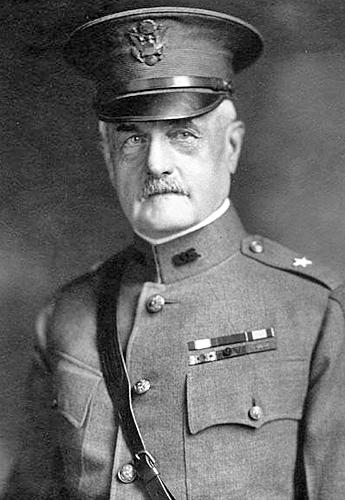

Samson Lane Faison
Commander 22nd Infantry
July 5, 1921- June 12, 1922
Samson L. Faison was born in Faison, Duplin County, North Carolina on November 29, 1860.
He entered the US Military
Academy on September 1, 1878. In 1879 he was turned back to
repeat his first year and graduated number 41 out of a class of
52 cadets on June 13, 1883.
His best subjects were Tactics and English and his worst subjects
were Engineering and Drawing.
In his junior year he was Quartermaster-Sergeant and in his
senior year he was a Lieutenant in the
Battalion Organization of Cadets.
Upon graduation he was commissioned a 2nd Lieutenant in Company C of the 1st Infantry.
|
Samson Lane Faison Graduation portrait from the 1883 |
Faison served on frontier duty
with his Regiment at Fort McDowell, Arizona from September 29 to
October 18, 1883. From that date he was at Fort Huachuca, Arizona
until August 12, 1884. From
August 12 to September 1 he was at Tombstone, Arizona then back
to Fort Huachuca. From May 19, 1885
to June 20, 1885 he was in the field on a scouting expedition
against the Apaches before returning to Fort
Huachuca. From July 28 to August 6 he was back in the field on
another scouting expedition at the end of
which he returned to Fort Huachuca.
Faison accompanied the
expedition led by Captain Emmet Crawford of the 3rd Cavalry
November 1885 to January 1886, which crossed into Mexico pursuing
Geronimo and Natchez,
two Apache chiefs. On that expedition Faison served as the
Adjutant, Quartermaster and Commissary
Officer. It was during this mission that 1st Lieutenant Marion
Maus of the 1st Infantry received the Medal
of Honor for his actions after assuming command of the expedition
upon the death of its commanding officer.
Faison also took part in General
Crook's final expedition into Mexico in early 1886 which
convinced Geronimo
to surrender to the American Army, returning to Fort Huachuca on
April 23, 1886.
Faison was mentioned in General
Orders of 1891 as "bearing uncomplainingly the almost
incredible fatigues
and privations as well as the dangers incident to operations
against hostile Apaches in Arizona and Sonora
during May 1885 and eleven months following."
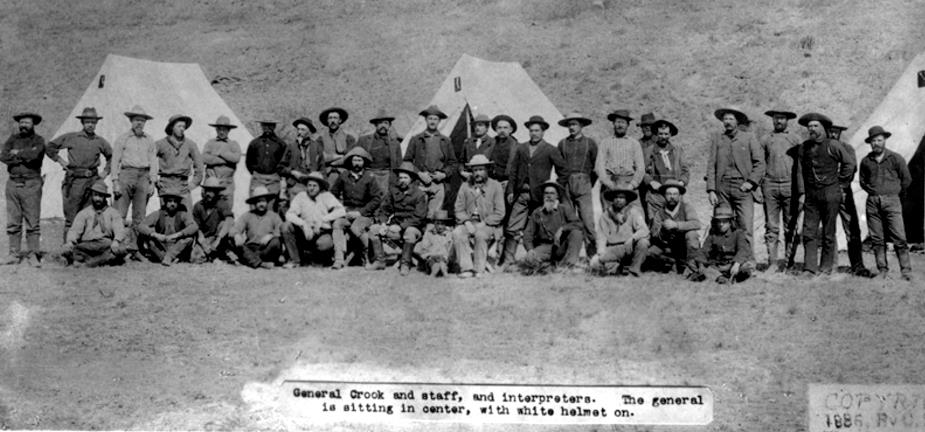
As a Lieutenant in the 1st Infantry,
Samson L. Faison accompanied General George Crook's expedition
into Mexico to persuade Geronimo to surrender in 1886. In the
photo above Samson Faison is standing, rear row,
eleventh from the left, directly behind General Crook.
Photo from Huachuca Illustrated Volume 7, 1999
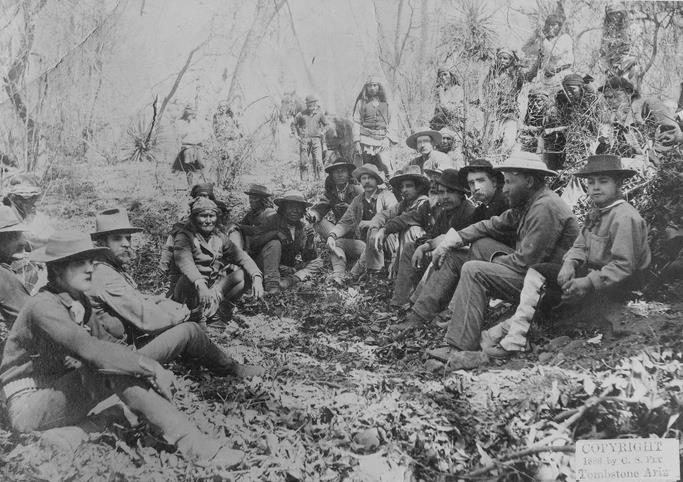
The meeting with Geronimo, March 25,
1886 at Canýon de los Embudos, in Sonora, Mexico.
General George Crook is second from the right in the white hat.
2nd Lieutenant Samson Faison is in the foreground, left.
To Faison's left is an unidentified officer and to that officer's
left is Geronimo.
Seated in the same line as Crook is 2nd
LT Marion Maus who would later command the 22nd Infantry in the
Philippines.
Maus is seventh from the right in the line, wearing a light
colored coat over his dark blue model 1883 campaign shirt.
From May 1-27, 1886 Faison was
on detached service near Tucson, Arizona enlisting new recruits
into the
Army's Indian Scouts. He was then at Fort Huachuca until July
when the 1st Infantry changed duty stations
to the Department of California. Faison was in garrison at the
Presidio of San Francisco, California from
July 16-31, 1886. He was on detached service at Fort McDermitt,
Nevada from July 31 to October 13 before
returning to the Presidio. He then took a leave of absence from
May 26 to September 20, 1887.
From June 21 to September 15,
1888 Faison was on duty at Santa Barbara, California. From
September 15, 1888
to April 18, 1889 he was stationed at Alcatraz Island, California
before returning to garrison duty at the Presidio.
He was at the summer camp of instruction at Monterey, California
from July 8 to August 19, 1889. He was on duty
at Santa Cruz, California from August 19 to September 18 when he
became stationed at Benicia Barracks, California.
Faison took a leave of absence
from November 19, 1889 to February 9, 1890. He remained with
Company C at
Benicia Barracks until December 1, 1890 when he reported to the
Engineer School at Willets Point, New York to
attend a course in submarine mining.
Faison was due for a promotion
but there was no slot open in the 1st Infantry so while at the
school on February 24, 1891
he was promoted to 1st Lieutenant in Company K of the 13th
Infantry. On July 20 a slot opened so he was transferred back
to the 1st Infantry and assigned to Company G. He finished the
course at the Engineer School and returned to the 1st
Infantry in California. He was on regimental recruiting service
in Oregon from December 1891 to March 1892 before
returning to the Regiment in California. In August and September
1894 he was on duty with his Company at Los Angeles
and Sacramento, California during the railroad strike. In
September he was part of the team inspecting the Nevada National
Guard at Carson City, Nevada. He was on general recruiting
service at Lynchburg, Virginia from October 1, 1895 to
October 10, 1896.
On October 21, 1896 Faison was
detailed to the Department of Tactics at the United States
Military Academy at West Point,
New York as an Assistant Instructor in Infantry Tactics. He would
remain on this detail for the next two and a half years. In 1897
and 1898 he would be officially assigned to Company K 1st
Infantry.
Faison was promoted to Captain of Infantry on July 1, 1898.
He was officially assigned to
the 13th Infantry on January 1, 1899 and was listed as the Senior
Instructor of Infantry Tactics
at the U.S. Military Academy. On April 20, 1899 his detail to the
Military Academy ended and he was given command of
Company M 13th Infantry.
Faison sailed from San Francisco
with the 13th Infantry on April 27, 1899 and arrived in Manila,
Philippines on June 1.
Ten days later in command of a company he took part in the first
engagement of the 13th Infantry in the Philippines,
in an attack on the entrenchments of Filipino insurgents on
Guadaloupe Ridge, near San Pedro Macati. He continued to
command a company in the field until July 13 when he was given
command of 2nd Battalion, a position he held from
July 13-August 6 and again from August 19-September 19. From
September 19 until early October he was on detached
service as Acting Adjutant-General of 1st Brigade 1st Division
8th Army Corps.
Faison commanded 1st Battalion
consisting of Companies B, D, E and F during a running engagement
with insurgents
October 8-10 in the area from Cavite and Viego to San Francisco
de Malabon. He continued in command of this Battalion
until October 28 when the Regiment was pulled back to Manila and
boarded boats to move up the coast to Lingayen Gulf
as part of a three pronged attack by the U.S. Army against
Aguinaldo's forces on Luzon. On November 4 he was again
given command of 1st Battalion and landed with it at San Fabian
on the coast of Lingayen Gulf on November 7. His Battalion
fought engagements with the insurgents upon and after the
landing. At Santa Neuvos and along the Rabon River his Battalion
was in engagements against insurgents on November 13.
Faison continued in command of
1st Battalion in Pangasinan Province of Northern Luzon while the
13th Infantry carried out
pacification operations including the establishment of civil
government and the building and repairing of roads and bridges
throughout the Province. The 13th Infantry Regimental history
records that "Under Captain Faison's direction another high
causeway covered with stone and gravel was built from the
Mangaldan River to San Jacinto and thence to the edge of
Manaoag."
These operations continued throughout the year 1900. On December
4, 1900 Faison was relieved of his duties with 1st Battalion
and appointed Judge of the Provost Court in "places
designated by the Commanding General 4th Brigade 2nd Division 8th
Army
Corps." He was on detached service from this duty at
Bautista as a member of the Military Commission from December
5-16, 1900.
Then he was on detached service at Manila as Judge Advocate of
the Military Commission from December 17, 1900 to January 29,
1901.
He was at San Jacinto as Judge
of the Provost Court from January 30 to February 16, 1901 then on
detached service at Binalonan
as a member of the Military Commission from February 17 to April
11. He was on detached service as a member of a General
Court Martial at Manila from April 12 to May 22. He temporarily
commanded Company L 13th Infantry on detached service at
Mangaldon from May 22 to July 1 and again from July 26 to August
21. Between July 1 and July 25 he was sick in the line of duty
in the hospital at Dagupan. From August 22-27 he was again sick
in the hospital at Dagupan.
Faison commanded the Military
Prison and Station of Lingayen from August 27 to September 4,
1901. He was on
detached service as Adjutant-General of the 3rd District,
Department of Northern Luzon from September 4 to
October 31. He was the Adjutant-General of the 1st Separate
Brigade from November 1 to December 30.
He resumed command of Company M
at Manila from January 21 to February 10, 1902. He was sick in
the line of duty
at the First Reserve Hospital at Manila from February 11-13. He
returned to command of Company M in garrison duty
at Manila on February 14. On June 11 Faison sailed with the
Regiment on board the U.S. Army Transport Sheridan
enroute to the United States by way of Nagasaki, Japan. The ship
passed through a typhoon July 2-4 with winds of 100 mph
and waves as high as 40 feet. The Sheridan arrived in
San Francisco on July 19.
Faison commanded Company M and
the post of Fort Mason, California from August 23 to October 12,
1902. He was
absent with leave from October 13, 1902 to January 24, 1903. He
then rejoined command of his company and the post of
Fort Mason and continued to command both through 1903, 1904 and
into 1905. He was on leave from May 25 to Aug. 11, 1905.
Faison resumed command of
Company M and the post of Fort Mason on August 11, 1905. He
continued in this position until
October when he was detailed for duty in the Army's Office of the
Quartermaster-General.
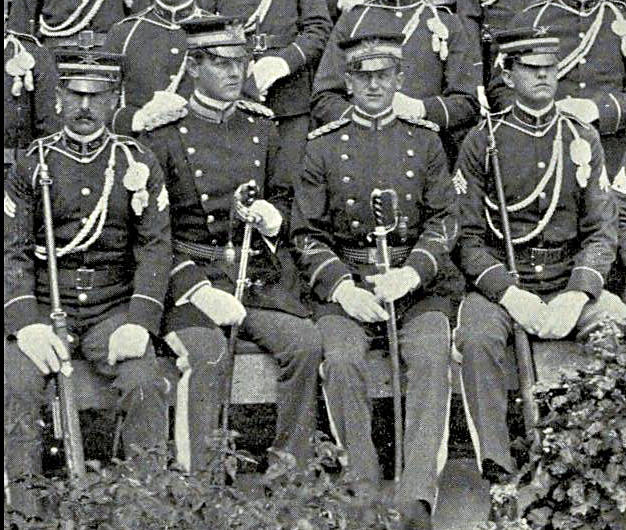
Second from left: Captain Samson Lane Faison as Commanding Officer of Company M 13th Infantry 1905
Photo from HISTORY of the
THIRTEENTH REGIMENT UNITED STATES INFANTRY by U.G. Alexander
Captain, Adjutant 13th Infantry published by Regimental Press,
Thirteenth Infantry FRANK D. GUNN 1905
Faison's detail for service and
to fill a vacancy in the Quartermaster Department began on
October 29, 1905.
He remained in the Quartermaster-General's Office until December
26, 1906. While there he received his
official promotion to Major of the 24th Infantry on June 30,
1906.
He sailed from San Francisco
bound for the Philippines on January 5, 1907. He was in command
of Camp Downs
as Major of the 24th Infantry on Leyte Island from February 17,
1907 to February 8, 1908. On February 20, 1908
he sailed from Manila bound for the United States via the Suez
Canal, arriving in New York on April 23. He took
leave until May 23 then joined the 24th Infantry at Madison
Barracks, New York. He remained on garrison duty
with the Regiment at Madison Barracks for the next two years.
Faison was assigned to the Army
War College in Washington, D.C. as a student officer on June 13,
1910.
While at the College he officially left the 24th Infantry and
received a promotion to Lieutenant Colonel of
Infantry unassigned to any regiment, the date of the promotion
being September 27, 1911. On April 17, 1912
he was assigned to the 5th Infantry Regiment. He left the War
College on July 1, 1912. (He had graduated
from the War College in June 1911 but stayed on as an
instructor.)
He was the Chief Umpire at the
Camp of Instruction at Mount Gretna, Pennsylvania from July 5 to
August 3, 1912.
He temporarily commanded the 5th Infantry Regiment during the
Connecticut Maneuvers and annual practice march
from August 9 to September 4, 1912. He served on garrison duty as
Executive Officer of the 5th Infantry Regiment
at Plattsburg Barracks, New York from September 4, 1912 to
November 10, 1914.
The outbreak of World War I in
the summer of 1914 caused much concern over the security of the
Panama Canal
and the 5th Infantry was ordered to the Canal Zone to augment the
forces there. Faison was enroute to the Canal
Zone from November 15-25, 1914. Beginning on November 25 he was
stationed at Empire in the Canal Zone.
He remained on duty with the 5th Infantry at Empire until October
2, 1915.
Faison was promoted to Colonel of Infantry unassigned to any regiment on October 2, 1915.
He was assigned to the 25th
Infantry and from January 25 to February 11, 1916 he was enroute
to Hawaii.
He assumed command of the 25th Infantry at Schofield Barracks,
Hawaii on February 12, 1916. He was on
leave and detached service from October 6, 1916 to January 12,
1917. On June 22, 1917 he was transferred to
the 42nd Infantry which was just being constituted at Fort
Douglas, Utah. Faison relinquished command of the
25th Infantry on July 6, 1917. He commanded the 42nd Infantry at
Fort Douglas from July 17 to August 20, 1917.
On August 20, 1917 Faison was
offered a temporary promotion to Brigadier General in the
National Army, a position
which he officially accepted on August 30.
On August 29, 1917 he was at
Camp Sevier, at Greenville, South Carolina commanding the 60th
Brigade
of the newly formed 30th Division. He temporarily commanded the
Division from December 22, 1917 to
May 17, 1918. He sailed for France via England on May 17,
arriving in Calais on June 8. He again temporarily
commanded the Division, this time in France from June 14 to July
20. Upon relinquishing command of the
Division to Major General Edward Mann Lewis in July 1918 Faison
continued command of the 60th Brigade.
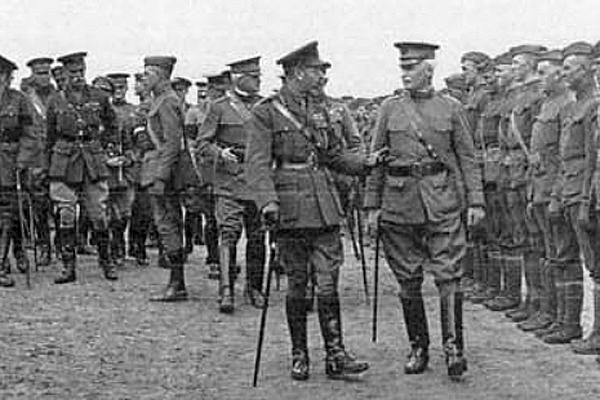
King George V of England
reviewing the troops of the 30th Division in France 1918.
King George is in the foreground, left, MG Edward M. Lewis is in
the foreground , right.
Over the right shoulder of the King and behind him is BG Samson
L. Faison
Photo from:
Borrowed Soldiers: Americans Under British Command, 1918
Volume 17 of Campaigns and commanders
Author Mitchell A. Yockelson
Edition illustrated
Publisher University of Oklahoma Press, 2008
ISBN 0806139196, 9780806139197
Faison was with the Division at
Watou, Belgium on July 4, 1918. He commanded the 60th Brigade in
the battles of:
the Canal Sector Defensive in Belgium July 16 to August 30 ( also
commanding the Division for the first four days
of the battle); the Ypres-Lys Offensive in Belgium August 31 to
September 2; and the Somme Offensive in France
September 24 to October 20. He was awarded the Distinguished
Service Medal for the part he and his Brigade played
in breaking the Hindenburg Line at Bellicourt, France during the
Somme Offensive. For the same action he was also
awarded the French Croix de Guerre and Legion of Honor.
After the armistice he was with
his Brigade in the Le Mans area in France. He left with the 30th
Division
from St. Nazaire, France on March 7, 1919, bound for the United
States, arriving in Charleston,
South Carolina on April 3, 1919.
From April 3, 1919 Faison was at
Camp Jackson, South Carolina again temporarily commanding the
30th Division
and Camp Jackson until May 1. He then commanded the 156th Depot
Brigade and the Demobilization Camp at
Camp Jackson as the 30th Division was demobilized and taken out
of service.
On July 15, 1919 Faison was
honorably discharged from the National Army and reverted back to
his permanent rank
of Colonel. He ended his detail at Camp Jackson on July 31, 1919.
He was at Camp Lee, Virginia commanding the
43rd Infantry from September 3, 1919 to March 1, 1921 when he
became unassigned to any regiment. In March
he reported to Fort Howard, Maryland where he was in charge of
National Army Officers at the Headquarters for 3rd Corps Area.
On July 5, 1921 Faison was assigned to the 22nd Infantry.
He assumed command of the 22nd Infantry at Fort Jay, Governors Island, New York on July 22, 1921.
On June 5, 1922 Faison was offered a promotion to Brigadier General which he accepted on June 14.
He relinquished command of the
22nd Infantry on June 12, 1922. He took a leave of absence from
August 1 to November 30, 1922 awaiting retirement.
On December 1, 1922 Samson Lane
Faison retired from the Army after 44 years of service.
He was given a disability in the line of duty.
He was a member of the Army-Navy
Club and of the Military Order of the Carabao. He joined
American Legion Post #1 in Raleigh, North Carolina in May 1929,
because he wanted to become
a member of the first American Legion Post in his home State.
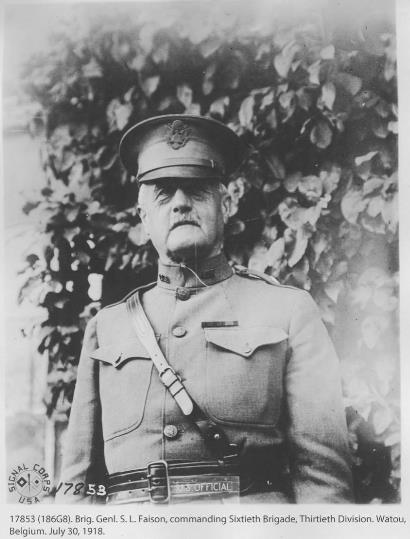
An official Army photo of BG Samson
Faison, taken in Belgium 1918
before he was awarded the Distinguished Service Medal
Photo from the North Carolina Digital Collection
Newspaper article
announcing the promotion Six months later Faison would
retire |
|
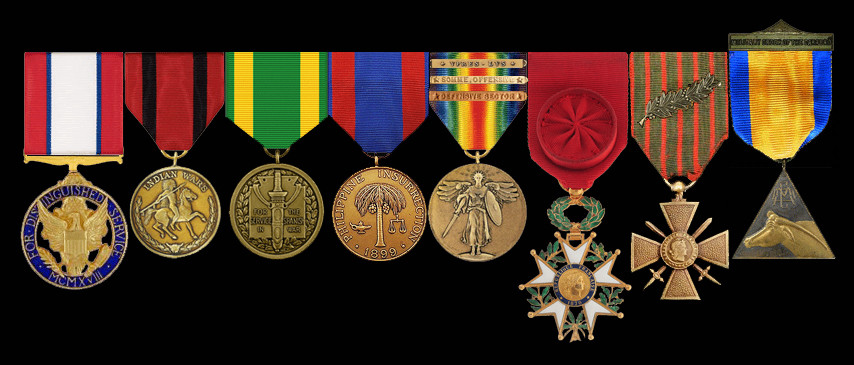
Samson Lane Faison's decorations
The citation for the Distinguished Service Medal presented to Samson L. Faison:
Citation:
The President of the United
States, authorized by Act of Congress, July 9, 1918, takes
pleasure in presenting the
Army Distinguished Service Medal to Sampson L. Faison, Brigadier
General, U.S. Army, for exceptionally meritorious
and distinguished services to the Government of the United
States, in a duty of great responsibility during World War I.
General Faison commanded with great credit the 60th Infantry
Brigade, 30th Division, in the breaking of the enemy's
Hindenburg line at Bellicourt, France, and in subsequent
operations in which important captures were made,
all marking him as a military commander of great energy and
determination.
War Department, General Orders
No. 59 (1919)
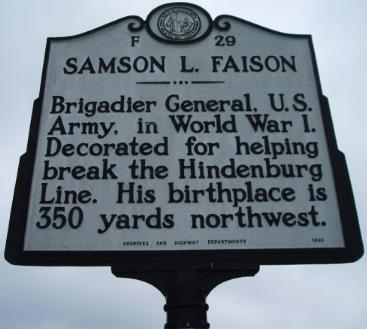
Historical Marker for Samson L. Faison
on US 117 (East Center Street)
in the city of Faison, North Carolina. Erected in 1950.
Samson Lane Faison, brigadier
general in the U. S. Army, was born November 29, 1860, in Faison.
He was educated
in private schools in the area, including Faison Academy. He was
appointed to the United States Military Academy at
West Point and graduated in June 1883 as a second lieutenant.
Faison was assigned to the First Infantry, serving under
General George Crook in Arizona against the Indians. He was
present at the council between Crook and Geronimo,
leader of the Chiricahua Apache, in Mexico in March 1886.
Faison was promoted to first lieutenant in 1891 and enrolled in
the Army’s Torpedo School. He became a recruiter
for a time and later became a senior instructor in the Infantry
Tactics Department at West Point. Promoted to captain in 1898,
Faison resigned from West Point the following year to fight in
the Philippines. While there he served as adjutant general
to several units and as judge advocate of military commissions
and judge of the provost court. When he returned to the
United States in 1903, Faison was given command of Fort Mason in
California and later was transferred to the
quartermaster general’s office in Washington, D. C. In 1906
he was promoted to major and returned to the Philippines,
where he commanded Camp Downs. Two years later he returned again
to the States and in 1910 was appointed to study
at the Army War College. After graduation he stayed on as an
instructor and administrator.
Progressively moving up in the Army ranks, Faison spent time in
Panama and Hawaii before the start of World War I.
On August 30, 1917, he was promoted to brigadier general of the
National Army (a wartime promotion) over the
Sixtieth Infantry Brigade of the Thirtieth ("Old
Hickory”) Division. During the war, his division served in
Belgium and France,
serving with distinction at the Hindenburg Line at Bellecourt,
France. There Faison’s troops were the first Americans
to break through the line, producing a victory for the Allied
forces. After the war, Faison returned to his rank of colonel.
He was promoted to brigadier general in the regular army on June
14, 1922. He retired less than six months later,
after having served in the Army for over forty years. Faison died
at his home in Baltimore in 1940
and was buried at Arlington National Cemetery.
North
Carolina Department of Cultural Resource
A photo of BG Samson L. Faison,
with his General's star Photo from the website Documenting the American South |
The identification disc
(dogtag) Photo from the website NCPEDIA |
SAMSON LANE FAISON
NO. 3009 CLASS OF 1883
Died October 17, 1940, at Baltimore, Maryland, aged 79 years.
BRIGADIER GENERAL SAMSON LANE
FAISON, United States Army, retired, died at his home in
Baltimore
after a most distinguished service of more than forty-four years.
He was born November 29, 1860,
at Faison, North Carolina, in the manor house still standing upon
an estate which
has been continuously in the family since the original crown
grant. His father, James Elias Faison, came of French Huguenot
and Dutch stock; his mother, Elizabeth Maria Lane, was of English
ancestry. Both families were of notable social, political,
and professional standing in the state.
Faison entered the Military
Academy as the "Sep" in 1878. A soldier by instinct,
with a keen brain and active body,
he quickly absorbed and enjoyed both the theoretical and
practical in military training. Handsome and agreeable,
a born leader, he became extremely popular with his fellow
cadets, at the same time winning the respect and
friendship of the official staff.
Upon graduation, in 1883, he was
assigned to the 1st Infantry which was then stationed in Arizona
Territory,
our last and perhaps one of our wildest frontiers at that time.
Over an enormous area, the Apaches were a scourge
to settlers, as they had been for centuries to the agricultural
Indian tribes. Although in 1872 they had been subdued
and placed on reservations by General George Crook, ten years
later their depredations necessitated the return of
General Crook for another four years of scouting and fighting. To
an ambitious fearless young officer the opportunity
for active service in such conditions against such an enemy was a
challenge far beyond the requirements of routine duty.
Faison was constantly in the field, generally with Indian Scouts,
earning the affection and approval of that stern critic,
General Crook. The climax of our last serious Indian campaign
occurred in May, 1885, when a band of Chiricahuas
under Geronimo, after a career of murder and rapine, retreated to
the fastnesses of the Sierra Madre Mountains in Mexico.
Faison was prominent in the pursuits and was one of the few
officers present at the council held by General Crook
with Geronimo when that wily savage promised to surrender.
The Apache campaign concluded,
the 1st Infantry was rewarded by station in the Department of
California.
From 1886 to 1890, as second and first lieutenant, Faison
remained with his original regiment in San Francisco
and nearby posts with a brief tour at long forgotten Fort
McDermitt, Nevada. Then, to round out his military education,
he took the course at the Torpedo School, Willets Point, N. Y.,
and graduated in 1891. In 1896 he was appointed
Senior Instructor of Infantry Tactics at the Military Academy, a
post he filled with great success, until relieved
at his own request early in the year 1899. His duties at the
Academy having kept him from service in the Spanish War,
he was determined to take part in the suppression of the
Philippine Insurrection. After leaving West Point,
Captain Faison sailed from San Francisco with the 13th Infantry.
From the date of its arrival in Manila, on May 29th,
the regiment was constantly in the field or billeted for brief
periods in various native villages. Within its first
two weeks ashore it was engaged at Guadeloupe Ridge and, soon
after, in sharp actions at Cavite Viejo and
San Francisco de Malabon, part of a running fight which lasted
for several days.
In November, 1899, the 13th
Infantry was included in General Loyd Wheaton's Expeditionary
Brigade
which proceeded by sea to disembark under fire and to capture San
Fabian on Lingayen Gulf, a strategic movement
which forced the evacuation of Dagupan, the terminus of the only
railroad, and opened direct communication
with Manila. This was followed by a skirmish at Rabon River and
later by the repulse of a strong night attack
by Insurgents upon the town of San Jacinto.
During this entire Philippine
tour, Faison was constantly being borrowed by higher commanders
for detached service
as Adjutant General of different units. Perhaps the most
valuable, even if less conspicuous duty, was that performed
in cleaning up the criminals left in the wake of the insurrection
and in re-establishing civil government. He was frequently
employed by the Division Commander, General MacArthur, as Judge
of the Provost Court and as Judge Advocate
of Military Commissions.
The Regiment sailed for home in
the fall of 1902 and upon arrival was stationed on Angel Island
with two companies
detached at Fort Mason—the latter at that time was probably
the most attractive station in the army, a beautiful
little park within the residential district of San Francisco.
Although not qualified by seniority, in recognition of his
accomplishments and reliability Faison was complimented with the
command of Fort Mason, where he served
for three years, until a detail to the Quartermaster's Department
sent him to the office of the Quartermaster General,
October 5, 1905. On December 19, 1906, just before the completion
of this tour, he married Miss Eleanor
Kerfoot Sowers, the daughter of Dr. Zachariah T. Sowers, a
well-known physician of Washington, D. C. Promoted to
major and assigned to the 24th Infantry, Faison sailed with his
bride to join his regiment in Leyte, P. I., where for about
a year he commanded Camp Downs. In February, 1908, he returned
home via Suez to station at Madison Barracks, N. Y.
Selected in 1910 for the coveted
detail to the War College, he graduated with such distinction
that he was retained
as Instructor for an additional year. Promoted to lieutenant
colonel on September 27, 1911, and assigned to the
5th Infantry at Plattsburg Barracks, New York, he joined in time
to command in the extensive maneuver exercises of 1912.
A colonel on October 2, 1915,
after a short tour in the Panama Canal Department, he joined his
new regiment,
the 25th Infantry, at Schofield Barracks, T. H. Upon entrance of
the United States into the World War, he was
transferred to the command of the 42nd Infantry at Fort Douglas,
Utah. In August, 1917, he was appointed
Brigadier General, National Army, and assigned to the 60th
Infantry Brigade, 30th Division, with station at Camp Sevier,
South Carolina. As senior Brigade Commander, he was, on several
occasions both before and after its arrival in France,
for considerable periods, in command of the Division. One of
these periods covered the return voyage from France
to the United States and thereafter.
Its training completed, the
Division was ordered to France, via England, arriving at Calais,
June 8, 1918. It was then
attached to a British Corps and served mostly in Belgium until
September 2, participating in many actions, such as:
Canal Sector (defensive), July 16th to August 30th; Ypres-Lys
(offensive), August 31st to September 2nd.
The Division was then transferred to participate in the Somme
offensive in France, September 2nd to October 20th, 1918.
After the Armistice, the
Division moved to the Le Mans Area where it remained until March,
1919, when it embarked
for the United States and took station at Camp Jackson, South
Carolina, for demobilization.
Faison reverted to his permanent
grade of colonel on July 15, 1919, and held several transitory
commands.
On June 5, 1922, while in command of the 22nd Infantry at
Governor's Island, New York, he was appointed
Brigadier General, United States Army. On December 1, 1922, he
was retired for disability incident to the service
and settled in Baltimore, Maryland.
Faison's career may be divided
into four stages. First, as an ambitious but inexperienced youth,
he found himself projected
into an active campaign against the fiercest Indians this country
ever knew, fighting over a terrain of unsurpassed military
difficulties where the enemy was at home but the troops at a
disadvantage. Our Indian campaigns were an unsurpassed
school of soldiering; they taught fortitude, self reliance,
vigilance, dexterity, in addition to practical application of the
principles governing the handling, supply, marching, and fighting
of American troops. For this early service he received
the unusual and enviable distinction of being mentioned in
General Orders 41, Headquarters of the Army, 1891, for
"bearing uncomplainingly the almost incredible fatigues and
privations as well as the dangers incident to operation
against hostile Apaches in Arizona and Sonora during May, 1885,
and eleven months following."
Second, was his comparatively
few years of duty as a Tactical Officer at West Point for which
he was outstandingly
qualified by character, accomplishment, professional knowledge,
and physical appearance. There was not a cadet at the
Academy during those years who was not influenced to some degree
by this officer who, if he was feared for the inflexibility
of his discipline, must be admired as an exemplar of the highest
soldierly type. He had one trait that never failed to excite
surprise, a photographic memory. He used to assert that after
three roll calls he knew every man in a company and that
after one week he was acquainted with every cadet in the corps.
Third, is the period of his
first tour in the Philippines where, although his combat record
was equal to all expectations,
his conduct of judicial affairs, "mopping up" as it
would now be called, was of inestimable value in pacifying
Northern Luzon.
His earliest ambition was to become a lawyer—here he had
opportunities to prove that he was as well fitted for the legal
profession as for the military. As an investigator he was rarely
deceived, as a judge he was stern and inflexible. No decision
of his was ever overruled. While he spoke neither Spanish nor any
native dialect, he could appear in a strange town and
within an incredibly short time develop a picture of current and
past delinquencies with the names and affiliations of
every prominent inhabitant. Once again his sterling character,
his knowledge of human nature, and his wide experience
brought him the support and friendship of such brilliant soldiers
as Generals Loyd Wheaton and William H. Bisbee.
Fourth, the crown of his career,
to which all of his prior service was but the preparation, was
his participation as a
fighting Brigade Commander in the World War. His D.S.M. citation
reads as follows: "He commanded with great credit
the 60th Infantry Brigade, 30th Division, in the breaking of the
enemy's Hindenburg Line at Bellicourt, France, and in subsequent
operations in which important captures were made, all marking him
as a military commander of great energy and determination."
His friends knew that
characterization to be well deserved. For him, as for the
reputation of many another, the war ended
too soon. Had America's participation lasted longer there is no
doubt that he could have aspired to the highest commands.
The French decorated him with the Croix de Guerre with Palms and
awarded him the rank of Officier in the Legion d'Honneur.
Field Marshal Lord Haig published a generous and laudatory
appreciation of the conduct and accomplishments of
the United States troops, including Faison's Brigade, while
attached to the British forces.
The following letters from those who knew him well best express the regard in which he was held by those in supreme command.
October 17, 1940.
My dear Mrs. Faison:
The sad news of the passing of General Faison fills me with deep
sorrow and my heartfelt sympathy goes out to you
in your bereavement. It is an irreparable loss that has come not
only to you but to the Army that he served so well
and to his many friends.
I recall our service together beginning more than forty years ago
and the memory of the intimate relationship that existed
between us over all these years gives me sincere pleasure. His
professional ability, and his fine loyal character
endeared him to all who had the privilege of his friendship.
If I may be of service to you now or at any time, my dear Mrs.
Faison, please let me know.
Very cordially yours,
John J. Pershing.
October 29th, 1940.
My dear Mrs. Faison:
In addition to my recent telegram extending to you the sympathy
of the War Department in the death of your husband,
General Faison, I wish to express more formally my personal and
official condolences.
During his long military career of more than forty years active
service, General Faison rendered exceptional service both
in peace and war. By the highly successful and loyal manner in
which he discharged the responsibilities entrusted to him,
he fully justified the confidence placed in him and brought
credit to himself and to the Army. His friends now on duty
in the War Department join me in expressions of sincere sympathy.
Faithfully yours,
George C. Marshall
Chief of Staff.
Like all strong personalities,
Faison made an unconscious distinction between his official and
his social character.
On duty he was reserved and cold, but at all times eminently
just. To him right and wrong were as black and white,
with no shades of grey. His innate dignity discouraged any undue
familiarity at any time or from any person.
Socially, on the contrary, he
was gay, sunny, and unaffected. His cadet nickname,
"Rube," of unknown origin,
clung to him through life and was affectionately known throughout
the army. The number of his friends and admirers was
that of his acquaintances. In his home he was a charming host
with the manners of the traditional southern gentleman.
During the evening of his life
on the retired list he suffered much physical pain, the result of
the demands made upon
a strong constitution during his early service. This only threw
his soldierly character into stronger relief, for pain brought
no complaint and his cheerfulness never failed. He was supported
by the constant affection of his many friends and by
the devotion of his wife and two children, Samson Lane Faison,
Jr., now Associate Professor of the History of Art
at Williams College, and Eleanor Sowers Faison, 2nd.
His interment was in Arlington National Cemetery, with full military honors, October 19, 1940.
So passed a gallant soldier, a loyal friend, a delightful companion, and an honest generous gentleman of whom:
May the better sort say
He's gone, and has left not behind him his fellow.
—L. H. B. ¹
Samson L. Faison died at Baltimore, Maryland on October 17, 1940.
He is buried in Arlington Cemetery,
Section 3, Grave 1878.
He was interred on October 19, 1940.
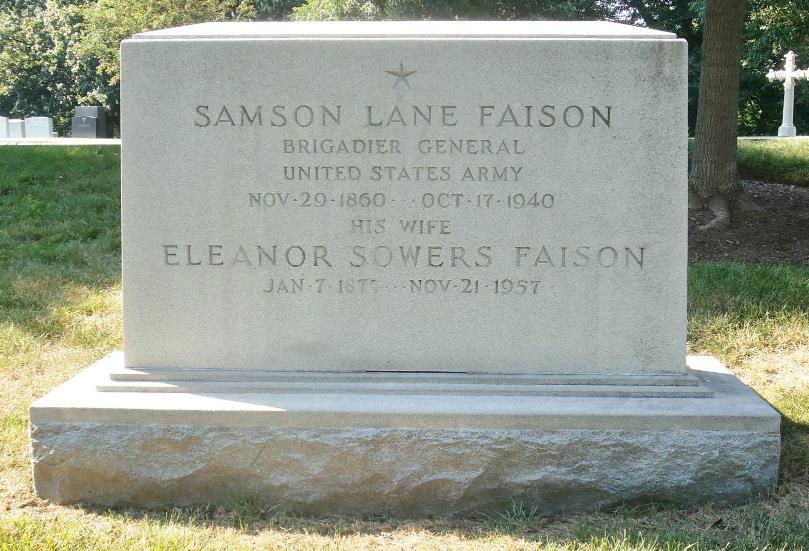
The grave monument for General Samson L. Faison in Arlington Cemetery
Photo by Paul Hays from the Find A Grave website
The Samson Lane Faison papers
are in the University of North Carolina Libraries
Southern Historical Collection
For more on Samson Lane Faison click on the following links:
Biography and photos: NCPEDIA
The personal memoir of Samson L.
Faison during the Geronimo campaign of 1885-1886
published by his Great Grandson Edward K. Faison:
Lieutenant Faison's Account of the Geronimo Campaign
Extensive coverage of the
Geronimo Campaign:
Huachuca Illustrated
The website is grateful for the assistance of
Edward Faison, the Great Grandson of General Samson L. Faison,
in the preparation of this page.
Top photo from the website NCPEDIA
"Photograph, Accession # : H.1918.23.1" 1918
North Carolina Museum of History
¹ SEVENTY-SECOND ANNUAL REPORT of the
Association of Graduates of the
United States Military Academy at West Point, New York June 10,
1941
The Moore Printing Company, Inc., Newburgh, New York
Additional Sources:
Official Army Registers 1879-1924
Adjutant General's Office
BIOGRAPHICAL REGISTER of the OFFICERS AND
GRADUATES of the U.S. MILITARY ACADEMY
at West Point, New York, Since Its Establishment in 1802 by
Brevet-Major-General George W. Cullum
VOL. III 1891, Supplement VOL. IV 1901, Supplement VOL. V 1910,
Supplement VOL. VI-A 1920,
Supplement VOL. VII 1930
HISTORY of the THIRTEENTH
REGIMENT UNITED STATES INFANTRY by U.G. Alexander
Captain, Adjutant 13th Infantry published by Regimental Press,
Thirteenth Infantry FRANK D. GUNN 1905
Dictionary of North Carolina
Biography: Vol. 2, D-G, Volume 2
Editor William S. Powell
Publisher Univ of North Carolina Press, 2000
ISBN 0807867012, 9780807867013
Home | Photos | Battles & History | Current |
Rosters & Reports | Medal of Honor | Killed
in Action |
Personnel Locator | Commanders | Station
List | Campaigns |
Honors | Insignia & Memorabilia | 4-42
Artillery | Taps |
What's New | Editorial | Links |